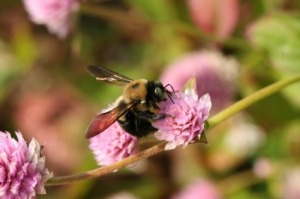 My son and his friend were playing in the bushes, little did we know there was a bee's nest lurking in there. The kids came out screeching after being stung several times, one was right on the tongue! Ouch!
My son and his friend were playing in the bushes, little did we know there was a bee's nest lurking in there. The kids came out screeching after being stung several times, one was right on the tongue! Ouch!
I used a wet aspirin to rub on their bee stings including the tongue. After 20 minutes you could not even tell they had been stung! It takes down swelling as well as helps with the pain. So it would be a good idea for your first aid kit.
Source: First aid book I read a few years ago. Can't remember which one!
By coville123 from Brockville
This page contains the following solutions.
If you have a bee sting, you can put a paste of baking soda and water on it. Just mix the baking soda and water together until it is very thick. Apply to bee sting after the stinger has been removed.
For pain relief from bee stings, immediantly put Orajel where you were stung. This is the same thing that babies use when they are teething. Also use with any other stings.
I saw this tip on the internet, if you get stung by a bee or hornet put a copper penny on the sting and hold it there for 15 minutes, it should take the sting away and should be no swelling.
For bee stings, my husband's grandmother used to always apply the cut side of an onion she had sliced in half to the bee sting for several minutes. Any pain or swelling, etc., will completely disappear. We have used this with our daughter, and now with our grandchildren with great success.
Mix baking soda (sodium bicarbonate) and water, adjusting until it makes a paste. Apply and leave it on the skin for 15 to 20 minutes.
Did you know that Afterbite's main ingredient is baking soda? If you make a paste of baking soda and water, it will stop the stinging very quickly.
Here are the questions asked by community members. Read on to see the answers provided by the ThriftyFun community.
Snuff is great for soothing bee and fire ant stings. Snuff may be a little hard to find; I use to buy it at the cigarette counter, but it is not longer available in my area. Find a friend in the South and they probably can find it for you.
Immediately, when you get stung, wet your hand, dip it in snuff, and rub vigorously. Reapply several times. This is pretty messy, so use over a floor than can be cleaned or outdoors. The pain goes away immediately. I have used this for over forty years. It has even worked with people who are highly allergic to bee stings.
I learned about this from an elderly pest control man. He had a customer who had been stung by a large number of bees. He went to the hospital and was told to be careful not to get stung again as he would die. My pest control man told him about snuff. When he did get stung again, used the snuff, and did not have an allergic reaction. Please use your Epi Pen for allergic reactions, but this will help too.
By Lucy from Marathon, FL

I know several people who are allergic to bee stings, bad enough to go into anaphalactic shock. Thanks for the tip, I'll definitely pass it along!
What is the best remedy for wasp and bee stings?
By maria r. from Blue Ridge, GA
My favorite is probably not everyone else's, but I use a baking soda and water paste, making it a little on the runny side and leave on for 15-20 min. for the stinger to float out and then clean it up and use peroxide and a little calamine to help the itch.
My volunteer firefighter neighbor says, and i have used it several times, straight bleach on a cotton ball soon as you can. Apply to skin for a few minutes but not too long.
Same as happy momma. also, a Benadryl type spray over the counter, spray on the bite. There is a liquid squeeze bottle called 'After Bite" at the pharmacy that has soothing menthol.
ThriftyFun is one of the longest running frugal living communities on the Internet. These are archives of older discussions.
Make a paste for a bee sting of baking soda and water. Rub this over the area where the bee has stung.